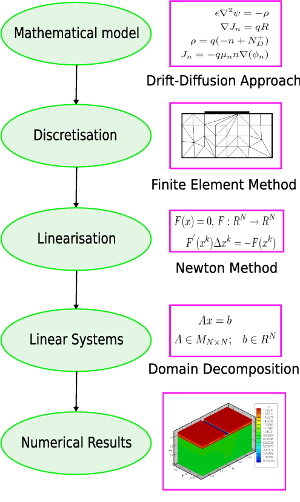Semiconductor Device Simulation
Computer Architecture Group
Departamento de Electronica e Computación - USC
Drift-Diffusion simulator

The 3D drift-diffusion (DD) heterostructure device simulator has been fully parallelised using MPI. To properly capture the confinement effects, quantum corrections have been included through the density gradient (DG) approach. The DD and DG equations have been discretised in the simulator via the finite element method (FEM).
When using this model, the Poisson, the density gradient and the continuity equation for electrons are solved consistently. These nonlinear equations are decoupled using Gummel iterations and linearized using the Newton–Raphson method. The linear systems are then solved in parallel using domain decomposition methods. To solve the local linear systems within each subdomain we have used Krylov subspace solvers, such as the FGMRES and the BiCGSTAB methods, preconditioned by incomplete LU factorizations dependent on both a numerical threshold and a certain level of fillin (standard ILUT preconditioner).
- Devices
- III-V MOSFET
- finFET
- Solar Cells
- Spintronics
- Simulation Tools
- Drift-Diffusion
- Monte Carlo
- Finite Elements
- Synopsys TCAD Sentaurus
- Contact
- People
- Contact us